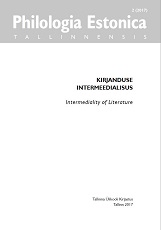Kurjuse intermeedialisest avaldumisest
Intermedial manifestations of evil
Author(s): Tanel LepsooSubject(s): Language and Literature Studies, Literary Texts, Film / Cinema / Cinematography, Theory of Literature
Published by: Tallinna Ülikooli Kirjastus
Keywords: film;novel;devil;ogre (vanapagan);image;Roland Barthes;
Summary/Abstract: The article explores evil as a medium, proceeding from Joachim Paech’s differentiation between the medium and its manifestations. In this light, evil is viewed as a phenomenon that can be expressed in only certain media forms and which therefore assumes different form-specific levels of meaning. Paying attention to different manifestations of evil makes it possible to analyse different intermedial aspects of works of art, making use of the notions of the overt and covert. The manifestation of evil in a perceptible and definable manner enables us to recognise, avoid or even overpower it. However, its covert and ambiguous manifestations are more powerful. Thus, the concealing of evil is characteristic of narratives that allow evil to manifest itself without direct reference to or overt representation of it. The visual representation of evil as an image, be it through mental description of images or physical images on the screen, reveals two contrastive regimes. One of them could, following Roland Barthes,be called obvious (obvie). Th is regime is characterised by the use of traditional rhetorical devices and its emphasis on symbolic expression.The second regime could be labelled obtuse (obtus). In this case, the focus is not on the meaning of the image, but its materiality. The article applies this theoretical apparatus to the analysis of two Estonian novels, The Misadventures of the New Satan (Põrgupõhja uusvanapagan) and Old Barny or November (Rehepapp ehk November) and their respective screen adaptation. It focuses on the image ofthe devil and, more broadly, the manifestations of evil. The analysis suggests that the first pair primarily displays the use of the obvious regime, accompanied by the obtuse; the second pair reverses the perspective. The aestheticisation of the obtuse emerges as the central feature of Old Barny or November as well as the visual design of its screen adaptation. The analysis also touches on the differences between the devil and the ogre (vanapagan in Estonian) and the more or less symbolic representations of the material elements associated with evil.
Journal: Philologia Estonica Tallinnensis
- Issue Year: 2/2017
- Issue No: 1
- Page Range: 11-34
- Page Count: 24
- Language: Estonian

